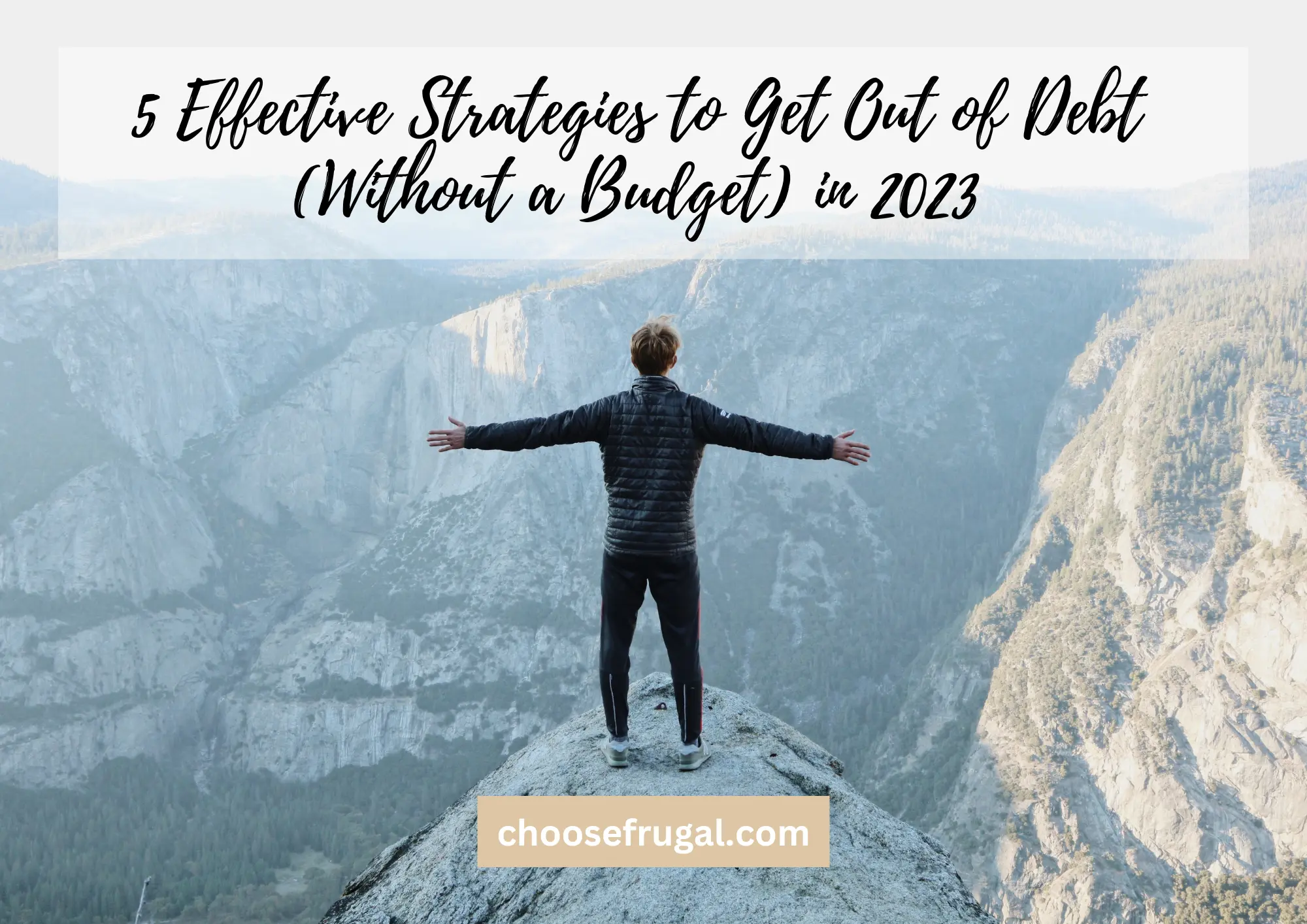
Introduction
Imagine the heavy shadow of debt looming over you. It’s a daunting specter, but there is a glimmer of light piercing through the gloom — a beacon of freedom from debt without the stress of stringent budgeting. This guide is your path to freedom, exploring five effective strategies and ways to get out of debt fast and without the traditional constraints of writing a budget in 2023.
If you’re wondering “How to get out of debt?” in 2023, here are 5 effective strategies that don’t require a strict budget. These methods are designed to help you overcome the burden of debt faster and get back to enjoying a debt-free life.
P.S. Want to know when our next post lands and get our free ebook on how to live frugally? Then click the link below.
Sign up here to claim your free ebook!
Understanding Debt and Its Impact
Before we delve into strategies on how to get out of debt or combat debt, it’s important to understand what debt is and how it affects you. Debt, whether it’s credit card debt, student loans, or mortgages, is borrowed money that you’re obligated to repay, usually with interest. The impact of debt on your personal finance and mental health can be considerable. It can hamper your ability to save, leading to stress, anxiety, and sleepless nights. For you to get out of debt it’s important that you not only know the strategies to get out of debt but also understand the impact of debt and getting out of debt.
The Snowball Strategy

The first approach to tackling debt without a stringent budget is the debt snowball strategy. It’s a simple but effective tactic to get out of debt. You start by focusing on your smallest debt. Make substantial payments on this debt while sticking to minimum payments on your other debts. This strategy allows you to eliminate your smallest debt quickly, giving you a sense of accomplishment and momentum to tackle the next smallest debt, and so on.
The debt snowball method. Here’s how it works: you start by making the minimum payments on all your debts except for the smallest one. For the smallest debt, you pay as much as you can. Once the smallest debt is paid off, you move on to the next smallest debt, and so on. This strategy helps to build momentum to repay debt faster and can provide a psychological boost as you start paying off your debts.
The snowball strategy is a powerful approach that uses the psychological power of small victories to maintain momentum in the debt repayment journey. It’s based on the principle that completing a task gives us a boost of satisfaction, which fuels our motivation to tackle the next task. In the context of debt repayment, the smallest debt is targeted first, ensuring a quick win that spurs on further action to pay off debt. As each debt is cleared, the amount that was being paid into that debt is then redirected to the next smallest debt, accelerating the personal loan repayment process. This ‘snowball effect’ can make a significant difference over time.
Watch this video by The Ramsey Show on What’s The Fastest Way To Pay Off Debt?
However, it’s important to note that while this strategy can provide a psychological boost, it may not be the most cost-effective strategy for all situations. If some of your larger debts have significantly higher interest rates, you could end up paying more in interest over time. Therefore, while the snowball debt repayment method can be a powerful tool in your debt repayment arsenal, it’s essential to assess your specific situation carefully and consider other debt settlement strategies as well.
The Avalanche Method

The avalanche method is another approach to get out of debt. It involves prioritizing debts with the highest interest rate. This strategy could potentially save you more money over a period of time because you’ll tackle high-interest debts before they accumulate. Although the avalanche method requires patience, it’s a worthwhile strategy if you keep your end goal in mind.
The avalanche method is a debt repayment strategy that prioritizes debts with the highest interest rate. It’s particularly effective in situations where there are significant differences in interest rates between all your debts. The logic behind this method is that by paying off the highest-interest debt first, you reduce the total amount of interest paid over time, which could result in significant savings.
The debt avalanche approach, is similar to the debt snowball method. This involves paying off debts with the highest interest rate first, which can save money over the long term. However, this method requires discipline and patience as the results may not be as immediate as the debt snowball method.
Despite its potential savings, the avalanche method requires patience, focus and discipline. Since it targets the highest interest debts first, which might also be the largest, it might take a longer time to eliminate these debts fully. This can be demotivating if you crave the satisfaction of completely paying off a debt faster. However, if you’re comfortable putting up with a longer-term strategy and the potential for greater financial benefit, the avalanche method could be a suitable approach for you.
Implementing a Spending Plan

Implementing a spending plan is another debt-reduction strategy. It’s not as restrictive as a conventional budget. Rather than limiting what you can spend, a spending plan focuses on your financial goals and helps you to put together a system to get out of debt. It empowers you to decide where your money should go, prioritizing spending according to your wants and needs. This proactive approach to debt management plan helps you maintain control over your money, avoiding the feeling of your money controlling you.
Unlike traditional budgets that can feel restrictive and punishing, a spending plan offers a more flexible and positive approach to managing your money. A spending plan is a proactive tool that gives you control over your money, rather than feeling like your money is controlling you. With a spending plan, you decide where your money goes each month. You map out your needs and wants, and prioritize your spending accordingly. This allows you to make conscious decisions about your spending habits, aligning them with your personal goals.
Creating a spending plan starts with understanding your income and expenses. Break down your spending into different categories and allocate a specific amount to each category. Remember, the purpose of a spending plan isn’t to limit your spending, but rather to ensure your money is being used in a way that benefits you. Make sure to include allocations for savings and debt repayment in your plan.
Watch this video by Insider Business on Easy Steps To Get Out Of Debt, According To A Certified Financial Planner
Building an Emergency Fund

Building an emergency fund is another critical strategy for managing debt without a budget. An emergency fund acts as a financial buffer, protecting you from spiraling into more debt when unexpected expenses arise. Start by aiming for a small fund that could cover a few weeks’ worth of expenses. Over time, increase this fund to cover several months’ expenses, ensuring peace of mind and financial stability. If you don’t have an emergency und you’ll find it difficult to get out of debt.
An emergency fund is a financial safety net designed to cover unexpected expenses. These might include car repairs, medical bills, emergencies, or sudden job loss. Without an emergency fund, such unforeseen expenses can lead to additional debt, undermining your existing debt and repayment efforts. An emergency fund gives you the peace of mind knowing you have funds available should an unexpected expense arise.
Building an emergency fund should be a priority. Start small, aiming to save enough to cover a few weeks’ worth of expenses. Gradually build this up until you have a reserve large enough to cover several months’ worth of living expenses. The size of your emergency fund will depend on your personal circumstances, including your income stability and your family situation. Remember, the goal isn’t just to create an emergency fund, but to continue adding to it over time.
Lifestyle Changes and Reducing Interest Rates

Adopting a more frugal lifestyle and reducing your expenses can also help manage your debt. Consider evaluating your current lifestyle and identifying areas where you could cut back. Additionally, lowering your interest rates can result in substantial savings over time. You can achieve this by using monthly payments, negotiating with lenders or consolidating loans. By doing this you’ll find it much easier to get out of debt.
Lifestyle changes can play a significant role in managing and reducing debt. This may involve cutting back on non-essential spending, such as dining out, entertainment, or luxury purchases. It could also mean making more frugal choices, like buying in bulk, cooking at home, or choosing less expensive alternatives for goods and services. By adopting a more mindful approach to spending, you can free up more money for debt repayment and savings.
Reducing your mortgage payments and interest rates can also be a powerful strategy for managing debt. High-interest rates can prolong your debt repayment and lead to higher total debt. Contact your lenders to negotiate lower interest rates. You could also consider options like balance transfers to credit cards with lower interest rates or consolidating your debts into a single loan with a lower interest rate. Just ensure that you fully understand the terms and conditions debt consolidation loan before making such changes.
Another strategy to consider is taking a debt consolidation loan. Debt consolidation loans allow you to lump all your debts together and consolidate debt into one single loan, typically with a lower interest rate. This means instead of managing multiple monthly payments, you’ll only have one monthly payment to keep track of. This could be particularly useful if you have high-interest credit card balances, student loans, or auto loans.
You can also try using a balance transfer card. These cards often offer a promotional period during which they charge low or zero interest. This allows you to pay down your debt faster as more of your payment goes towards the principal amount, rather than the interest.
Another method to get out of debt is engaging a credit counseling organization. These organizations can negotiate with your credit card issuer or other lenders on your behalf, potentially reducing your interest rate and monthly payment. They can also provide you with a debt management plan and financial advice to prevent further accumulation of debt.
How Can Debt Reduction Benefit You?

Reducing and eventually eliminating debt not only gives you financial freedom but also alleviates psychological stress. It allows you to save for your future, improve your credit score, and relieve the mental burden that comes with debt. The end result of debt-free you? A healthier, happier you with more opportunities and greater freedom.
The benefits of debt reduction go far beyond the financial sphere, influencing multiple aspects of life and well-being. At its core, the idea of reducing and eventually eliminating debt helps establish a stable and secure financial foundation, giving you the freedom to use your income towards achieving your personal and financial goals rather than servicing debt.
One tangible benefit of reducing debt is the ability to save more effectively for the future. Whether your goals include buying a home, starting a business, or retiring comfortably, reducing your debt enables you to direct more funds towards these long-term goals. This added financial freedom also allows you extra cash to invest, leading to potential wealth growth over time. If you have savings it will help you get out of debt in the future if you ever end up in bad debt.
Reduction in debt also results in an improved credit score. Your credit score is a numerical representation of your creditworthiness and is used by lenders, landlords, other companies, and sometimes employers to gauge your financial responsibility. High levels of debt, particularly if the debt balances associated with late or missed payments, negatively impact your credit score. As you reduce your debt and manage your payments responsibly, your credit score will improve, making it easier and often cheaper to secure loans, housing, other accounts, and other financial products in the future.
Beyond the financial realm, carrying debt can often lead to significant psychological stress, contributing to anxiety, depression, and even physical health issues like insomnia or high blood pressure. The persistent worry about making payments, dealing with creditors, or bankruptcy or facing the consequences of missed debt payments can be mentally exhausting. As you reduce your debt, you’ll likely experience some relief and a corresponding reduction in these stress levels, leading to better mental and physical health.
In addition, reducing debt can improve your overall quality of life. Financial struggles and personal loans often lead to strained relationships and limited personal opportunities. Eliminating debt can alleviate these strains, opening the door to healthier relationships and greater personal freedom.
Regardless of the strategy you choose, it’s important to have an emergency savings fund. Unexpected expenses can arise and having a fund to dip into can prevent you from accumulating more debt. Also, try to find extra income, perhaps through a part-time job, and put this towards your debt payments.
In summary, the benefits of debt reduction extend far beyond the obvious financial implications. From mental health to personal relationships, reducing debt can have a profound impact on overall well-being and life satisfaction. It’s why debt consolidation is a journey worth embarking on for a healthier, happier, and financially secure future.
Frequently Asked Questions
What is the difference between good debt and bad debt?
Good Debt:
Good debt is generally considered an investment that will grow in value or generate long-term income. Taking on good debt can contribute positively to your financial future. Here are some examples:
- Mortgages: Real estate often increases in value over time and the interest on mortgage loans is tax-deductible.
- Student Loans: Investing in education can lead to better job opportunities and higher income in the future, so this is often considered good debt, despite being a large financial commitment.
- Business Loans: Money borrowed to start or expand a business can be considered good debt as it’s an investment with the intention of generating more income.
Bad Debt:
Bad debt, on the other hand, involves borrowing money to purchase depreciating assets or goods and services that don’t have lasting value. Here are some examples:
- Credit Card Debt: This is often considered bad debt because the high-interest rates make it costly, and it’s typically used to purchase consumer goods that depreciate.
- Car Loans: While not always avoidable, car loans can be considered bad debt because vehicles rapidly lose value.
- Payday Loans: These short-term, high-interest loans are almost universally considered bad debt and should be avoided whenever possible.
It’s important to remember that the distinction between good and bad debt isn’t black and white, and often depends on one’s personal financial situation and goals. Always consider your ability to manage and repay the debt before borrowing. Good debt is usually helpful on your journey to get out of debt, whereas bad debt will usually hinder your attempt to get out of debt. It might even put you deeper into debt.
What is the snowball method?
The snowball method is an example of a debt reduction strategy where you pay off debts in ascending order from smallest to largest in monthly payment, gaining forward momentum as each balance is paid off.
How does a spending plan work?
A spending plan is a proactive way of managing money. It’s based on your personal goals and lifestyle and prioritizes your finances and balances your spending according to your needs and wants.
Why is an emergency fund important?
An emergency fund acts as a financial safety net for unexpected expenses, other costs, preventing you from falling into deeper debt. It contributes to your overall financial stability and peace of mind.
How do I get myself out of debt?
The first step to getting out of debt is acknowledging it and making a plan to tackle it head-on. Make a list of all your debts, then prioritize paying off those with the highest interest rates. Consider strategies like the debt snowball method (paying off small debts first to build momentum) or the debt avalanche method (paying off debts with the highest interest rates first to save money). Also, cut back on unnecessary expenses, create an emergency fund to prevent future debt, and consider consulting with a financial advisor. Remember, progress might seem slow, but stay persistent and keep your eyes on the goal – a debt-free life!
Is $20,000 debt a lot?
Whether $20,000 in debt is considered “a lot” depends on your personal financial situation and the nature of the debt. If it’s a low-interest mortgage or student loan and your income comfortably covers the repayments on monthly bills, it’s manageable. However, if it’s high-interest credit card debt and you’re struggling with minimum payments, it might be a significant burden. The golden rule is that your total debt (excluding a mortgage) should not exceed 20% of your net annual income. If it does, it might be time to reassess your debt repayment strategy.
How to pay off $10,000 in a year?
Paying off $10,000 in a year equates to roughly $833 a month. The key is to budget effectively and generate additional income wherever possible every month. Start by reviewing your monthly income and expenses, identifying areas for potential savings. It could be as simple as cooking meals at home or as challenging as negotiating lower rates on utilities or insurance. Then, consider supplementing your income, perhaps with a side job or by selling unused items. The crucial part is committing to apply all these extra funds to your debt.
How to get out of 50k debt in one year?
Clearing $50,000 of debt in a year is a substantial goal, requiring a monthly repayment of about $4,166. This will likely involve significant lifestyle changes. First, create a strict budget prioritizing necessities over luxuries. Then, look for ways to increase your income – take on a part-time job, sell unused items, or freelance in your spare time. If possible, consider debt consolidation or renegotiating your interest rates with lenders. However, if your income doesn’t support this level of repayment, it might be more realistic to aim for a longer repayment period. Always consult with a financial advisor before making significant financial decisions.
Wrapping Up
Living under the burden of debt doesn’t have to be your destiny. By employing strategies like the debt snowball method, and avalanche methods, implementing a spending plan, building an emergency fund, and making lifestyle changes, you can pave your path toward financial independence. It’s time to seize control, break free from the shackles of debt, and embark on your journey toward financial freedom.
Remember, getting out of debt involves making necessary adjustments to your spending habits and financial situation. Don’t forget to check your credit report regularly to monitor your progress and make sure all your payments are being accurately reported. With determination and a solid strategy, you can overcome your debt and move towards your financial goals.
Thank you for reading this article! If you enjoyed it, be sure to check out our other articles to help you manage your financial situation and live a frugal life.
Budgets for beginners: A guide to creating and sticking to one
Mastering Your Budget: The 37 Untold Secrets of How to stick to a budget
18 Actionable Steps for Millennials to Build a Strong Financial Future
How to Save Money Fast: The Ultimate Guide to Saving $2,000 a Month
Why Is It Hard To Save Money? (2 reasons)
Best Wedding Reception Order of Events for Your Big Day (4 steps to planning)
9 Frugal living tips for 2022 (and beyond)
10 Top Tips for Planning a Wedding on a Budget You’ll Love
P.S. Want to know when our next post lands and get our free ebook on how to live frugally? Then click the link below.